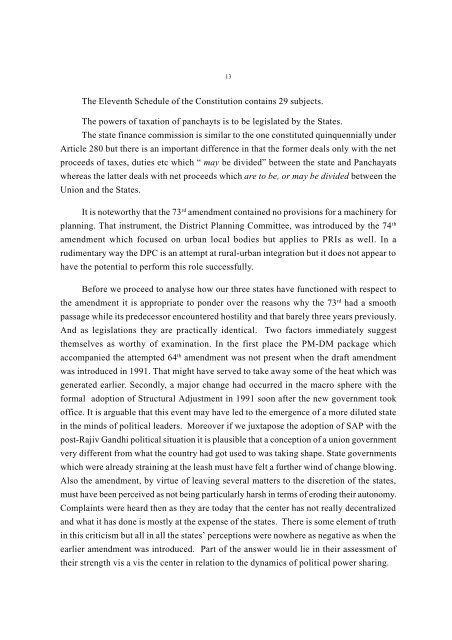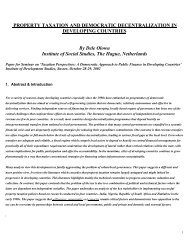View Article - Institute of Development Studies
View Article - Institute of Development Studies
View Article - Institute of Development Studies
You also want an ePaper? Increase the reach of your titles
YUMPU automatically turns print PDFs into web optimized ePapers that Google loves.
13The Eleventh Schedule <strong>of</strong> the Constitution contains 29 subjects.The powers <strong>of</strong> taxation <strong>of</strong> panchayts is to be legislated by the States.The state finance commission is similar to the one constituted quinquennially under<strong>Article</strong> 280 but there is an important difference in that the former deals only with the netproceeds <strong>of</strong> taxes, duties etc which “ may be divided” between the state and Panchayatswhereas the latter deals with net proceeds which are to be, or may be divided between theUnion and the States.It is noteworthy that the 73 rd amendment contained no provisions for a machinery forplanning. That instrument, the District Planning Committee, was introduced by the 74 thamendment which focused on urban local bodies but applies to PRIs as well. In arudimentary way the DPC is an attempt at rural-urban integration but it does not appear tohave the potential to perform this role successfully.Before we proceed to analyse how our three states have functioned with respect tothe amendment it is appropriate to ponder over the reasons why the 73 rd had a smoothpassage while its predecessor encountered hostility and that barely three years previously.And as legislations they are practically identical. Two factors immediately suggestthemselves as worthy <strong>of</strong> examination. In the first place the PM-DM package whichaccompanied the attempted 64 th amendment was not present when the draft amendmentwas introduced in 1991. That might have served to take away some <strong>of</strong> the heat which wasgenerated earlier. Secondly, a major change had occurred in the macro sphere with theformal adoption <strong>of</strong> Structural Adjustment in 1991 soon after the new government took<strong>of</strong>fice. It is arguable that this event may have led to the emergence <strong>of</strong> a more diluted statein the minds <strong>of</strong> political leaders. Moreover if we juxtapose the adoption <strong>of</strong> SAP with thepost-Rajiv Gandhi political situation it is plausible that a conception <strong>of</strong> a union governmentvery different from what the country had got used to was taking shape. State governmentswhich were already straining at the leash must have felt a further wind <strong>of</strong> change blowing.Also the amendment, by virtue <strong>of</strong> leaving several matters to the discretion <strong>of</strong> the states,must have been perceived as not being particularly harsh in terms <strong>of</strong> eroding their autonomy.Complaints were heard then as they are today that the center has not really decentralizedand what it has done is mostly at the expense <strong>of</strong> the states. There is some element <strong>of</strong> truthin this criticism but all in all the states’ perceptions were nowhere as negative as when theearlier amendment was introduced. Part <strong>of</strong> the answer would lie in their assessment <strong>of</strong>their strength vis a vis the center in relation to the dynamics <strong>of</strong> political power sharing.





